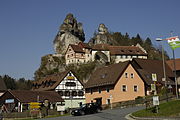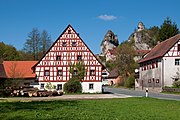Tüchersfeld
|
Tüchersfeld
City of Pottenstein
Coordinates: 49 ° 47 ′ 9 ″ N , 11 ° 21 ′ 38 ″ E
|
|
|---|---|
| Height : | 337 m above sea level NHN |
| Postal code : | 91278 |
| Area code : | 09242 |
Tüchersfeld is a church village in the Püttlachtal in Franconian Switzerland and belongs to the town of Pottenstein .
geography
Due to its distinctive rocks ( sponge reefs in conical karst forms ) of a circulating mountain , created by uplifting the Franconian Jura in the Young Tertiary and the removal of the mighty sand cover from the Upper Cretaceous, and the location of the half-timbered houses, which seem to be partially glued to the rocks, Tüchersfeld is considered one Symbol for Franconian Switzerland and is depicted on a Deutsche Post stamp. Two castles existed there until the Thirty Years' War , the Upper and the Lower Castle . The latter was first mentioned in 1269 as a fortress that had existed for a long time.
Geotope
The rock castle has been designated by the Bavarian State Office for the Environment (LfU) as a geoscientifically valuable geotope (geotope number: 472R156). It was also awarded the official seal of approval for Bavaria's most beautiful geotopes by the LfU .
history
Tüchersfeld is the oldest settlement in the large community of Pottenstein, which was first mentioned in 1243. Two castles in Tüchersfeld are known from 1323. Oberntüchersfeld , of which there are hardly any traces left, was on the flagstone. Niederntüchersfeld , which was built after Oberntüchersfeld Castle, is known today as the Judenhof. In 1323 an office was set up in part of Oberntüchersfeld Castle.
In 1442 the bishop of Bamberg pledged the office and castle of Oberntüchersfeld to Heinrich Gareis. From 1329 to 1959, Niederntüchersfeld was almost exclusively owned by various branches of the Groß family, was destroyed by rebellious farmers in 1525, but then rebuilt. The castle came to an end with the Thirty Years' War. Except for the outbuildings, it was destroyed.
The former Judenhof, a group of buildings from the 17th and 18th centuries, built by Jews on the grounds of the Lower Castle, was inhabited by 18 Jewish families until 1860. It was repaired from 1978 to 1982 and is now the Franconian Switzerland Museum . The synagogue from the second half of the 18th century (around 1763) is remarkable with its simple late baroque stucco frame on the ceiling; After decades of misappropriation, little can still be seen of the former design.
The Catholic branch church Herz Jesu was built in 1950/51 on the basis of a foundation; with the tower it is attached to another building. Behind the high altar , a painting by Otelia Kraszewska ( Gößweinstein ) shows Christ in a white robe, turning to people of different ages. On the side altar, a painting by Anna Maria Freiin von Oer (Gößweinstein) depicts a Madonna with baby Jesus. The ceiling paintings, including the Lamb of God and the four evangelists , the pictures on the gallery and the Way of the Cross are by Giovanni Bruno (Gößweinstein).
On January 1, 1972, the municipality of Tüchersfeld was dissolved. Their area was added to the town of Pottenstein and the market Gößweinstein (the places Hühnerloh and Kohlstein).
Architectural monuments
In the list of architectural monuments in Pottenstein (Upper Franconia) there are six architectural monuments for Tüchersfeld .
literature
- Franz X. Bogner: Franconian Switzerland. An aerial portrait. Ellwanger Verlag, Bayreuth 2007, ISBN 978-3-925361-62-3 , pp. 78-82.
- Johann Kaspar Bundschuh : Tüchersfeld . In: Geographical Statistical-Topographical Lexicon of Franconia . tape 5 : S-U . Verlag der Stettinische Buchhandlung, Ulm 1802, DNB 790364328 , OCLC 833753112 , Sp. 593 ( digitized version ).
- Pleikard Joseph Stumpf : Tüchersfeld . In: Bavaria: a geographical-statistical-historical handbook of the kingdom; for the Bavarian people . Second part. Munich 1853, p. 625 ( digitized version ).
- Gerhard Philipp Wolff, Walter Thousand Pounds: Tüchersfeld and the Judenhof. In: Jewish life in Franconian Switzerland. (= Publication series of the Franconian Switzerland Association, Volume 11). Palm & Enke, Erlangen / Jena 1997, pp. 191-220.
Web links
- Tüchersfeld . In: Pottenstein.de
- Tüchersfeld - This rock village has merged with nature . In: Geo.de
Individual evidence
- ↑ "How did the relief of Franconian Switzerland come about? Upper Cretaceous to this day." Sign for the Geotopweg Pottenstein in Tüchersfeld
- ^ "Franconian Switzerland Museum." Information board in front of the museum
- ↑ Bavarian State Office for the Environment, Geotop Felsburg Tüchersfeld (accessed on October 12, 2017).
- ↑ Bavaria's most beautiful geotopes, Felsburg Tüchersfeld (accessed on November 2, 2017)
- ↑ Tüchersfeld with Arnleiten and Racker Mountain - Town Pottenstein. Retrieved June 14, 2018 .
- ^ "Franconian Switzerland Museum." Information board in front of the museum
- ↑ Georg Dehio: Handbook of the German. Kunstdenkmäler, Bavaria I: Franken, 1999, p. 1035
- ↑ Explanation board No. 29 in the museum.
- ↑ Peter Poscharchsky: The churches of Franconian Switzerland, Erlangen, 4th edition, 2001, p 375
- ^ Wilhelm Volkert (ed.): Handbook of Bavarian offices, communities and courts 1799–1980 . CH Beck, Munich 1983, ISBN 3-406-09669-7 , p. 550 .









